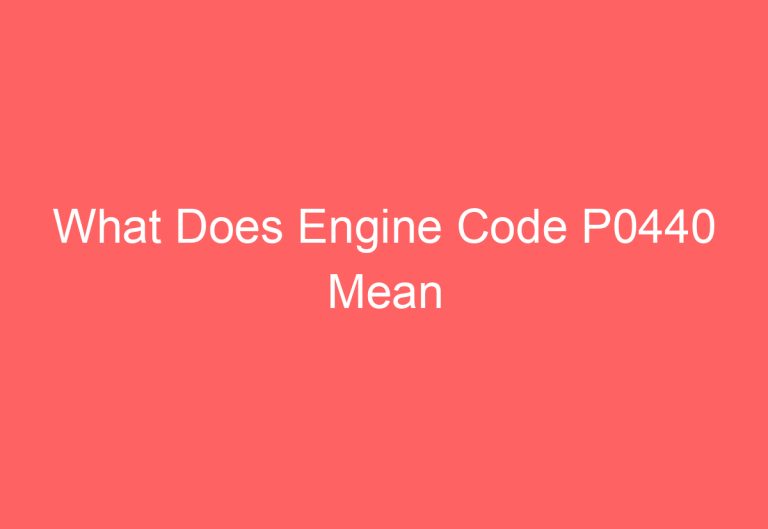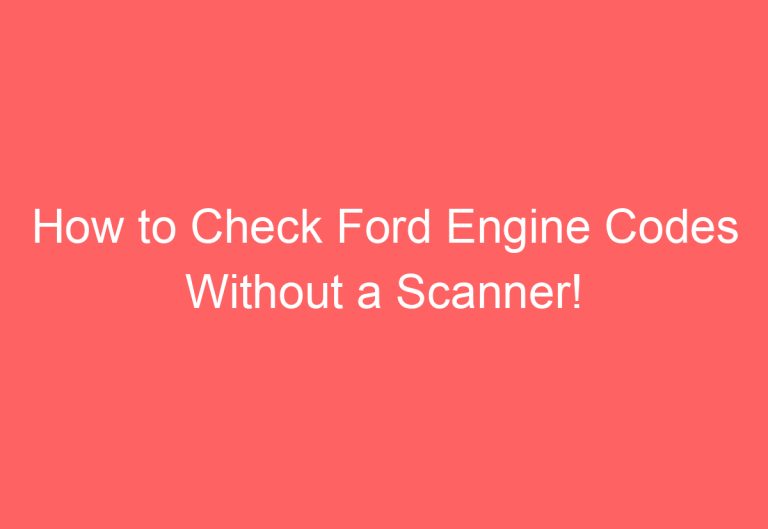6 Misfiring Engine? Here’s How to Fix It!
The Check Engine Light (CEL) is a warning light on your dashboard that indicates a problem with your vehicle’s engine. The CEL can be caused by a variety of issues, from a simple misfire to a more serious problem. It’s important to have the CEL checked as soon as possible, as it could indicate a problem that could lead to further damage to your vehicle.
There are a few different ways to check your engine code. You can use a scan tool, which is a device that plugs into your vehicle’s OBD-II port and reads the codes. You can also check your engine code by using a code reader, which is a handheld device that reads the codes from your vehicle’s computer. Finally, you can also check your engine code by looking at your vehicle’s owner’s manual.
Once you have the engine code, you can look it up in a service manual or online to find out what it means. The code will usually tell you what system is causing the problem and what the problem is. You can then take your vehicle to a mechanic to have the problem diagnosed and repaired.
So How To Check Engine Code
6 Misfiring Engine Here’s How to Fix It!
A misfiring engine is one that is not firing all of its cylinders properly. This can cause a number of problems, including decreased fuel economy, increased emissions, and decreased power. There are a number of things that can cause a misfiring engine, including:
A bad spark plug
A bad ignition coil
A bad fuel injector
A dirty or clogged fuel filter
A vacuum leak
A bad camshaft or crankshaft sensor
If you are experiencing a misfiring engine, it is important to have it diagnosed and repaired as soon as possible. A misfiring engine can damage other components of your vehicle, and it can also be dangerous to drive.
Here are some tips on how to fix a misfiring engine:
1. Check the spark plugs and ignition coils:
If the spark plugs are worn out or damaged, they will not be able to produce a spark strong enough to ignite the fuel. Ignition coils can also fail, which will prevent the spark plugs from firing.
2. Check the fuel injectors:
If the fuel injectors are dirty or clogged, they will not be able to deliver the proper amount of fuel to the engine. This can cause the engine to misfire.
3. Check the fuel filter:
A dirty or clogged fuel filter can restrict the flow of fuel to the engine, which can also cause the engine to misfire.
4. Check for vacuum leaks:
A vacuum leak can cause the engine to run lean, which can lead to misfiring.
5. Check the camshaft or crankshaft sensor:
These sensors help the engine to synchronize the firing of the cylinders. If they are faulty, the engine may misfire.
If you are unable to fix the misfiring engine yourself, it is important to take it to a qualified mechanic. They will be able to diagnose the problem and make the necessary repairs.
How to Check Engine Code
Understanding the Check Engine Light
When your vehicle’s check engine light comes on
it’s a signal that the onboard diagnostic system (OBD) has detected a potential issue with the engine
transmission
or emissions system. It’s essential to address the underlying problem promptly to prevent further damage and ensure optimal vehicle performance. Checking the engine code is the first step in diagnosing the issue.
Using an OBD-II Scanner
One of the most effective ways to check engine codes is by using an OBD-II scanner. As a modern automotive manufacturer
we highly recommend investing in a quality OBD-II scanner
which is readily available from various retailers and online stores. These scanners are designed to communicate with your vehicle’s onboard computer system and retrieve specific diagnostic trouble codes (DTCs) related to the check engine light.
Locating the OBD-II Port
Before using an OBD-II scanner
it’s crucial to locate the OBD-II port in your vehicle. The OBD-II port is typically located under the dashboard on the driver’s side. Once you’ve found the port
simply plug in the OBD-II scanner and follow the manufacturer’s instructions to retrieve the diagnostic trouble codes.
Interpreting Diagnostic Trouble Codes
Once you’ve retrieved the diagnostic trouble codes using the OBD-II scanner
it’s important to interpret the codes accurately. These codes consist of alphanumeric characters and provide valuable information about the specific issue detected by the onboard diagnostic system. As a dealership
our trained technicians have the expertise to interpret these codes and pinpoint the root cause of the problem.
Seeking Professional Assistance
If you’re unsure about how to interpret the diagnostic trouble codes or if the underlying issue requires advanced diagnostics and repairs
we strongly advise seeking professional assistance from our certified technicians. Our dealership is equipped with state-of-the-art diagnostic tools and resources to accurately diagnose and address any check engine light concerns.
Regular Maintenance and Monitoring
Preventive maintenance is key to minimizing the occurrence of check engine light issues. As an automotive manufacturer
we emphasize the importance of adhering to scheduled maintenance intervals and keeping an eye on your vehicle’s overall performance. Addressing any unusual symptoms promptly can
FAQs: How to Check Engine Code
What is an engine code?
An engine code is a series of letters and numbers that are used to identify a specific problem with a vehicle’s engine. Engine codes are typically stored in the vehicle’s computer, and can be retrieved using a scan tool.
How do I check my engine code?
There are a few different ways to check your engine code. You can use a scan tool, a code reader, or a smartphone app. Scan tools and code readers are available at most auto parts stores, and smartphone apps can be downloaded from the App Store or Google Play.
What do the different engine codes mean?
Engine codes can have different meanings depending on the manufacturer and the specific problem. However, some common engine codes include:
P0171: Fuel System Too Lean
P0174: Fuel System Too Rich
P0300: Random Misfire
P0420: Catalytic Converter Efficiency Below Threshold
P0430: Evaporative Emission System Leak
What should I do if I get an engine code?
If you get an engine code, it is important to have the problem diagnosed and repaired as soon as possible. Ignoring an engine code can lead to further damage to your vehicle, and could even make it unsafe to drive.
How much does it cost to fix an engine code?
The cost of fixing an engine code can vary depending on the specific problem. However, in general, engine code repairs can range from a few hundred dollars to a few thousand dollars.
Example of FAQs in HTML format
“`
FAQs: How to Check Engine Code
What is an engine code?
An engine code is a series of letters and numbers that are used to identify a specific problem with a vehicle’s engine. Engine codes are typically stored in the vehicle’s computer, and can be retrieved using a scan tool.
How do I check my engine code?
There are a few different ways to check your engine code. You can use a scan tool, a code reader, or a smartphone app. Scan tools and code readers are available at most auto parts stores, and smartphone apps can be downloaded from the App Store or Google Play.
What do the different engine codes mean?
Engine codes can have different meanings depending on the manufacturer and the specific problem. However, some common engine codes include:
- P0171: Fuel System Too Lean
- P0174: Fuel System Too Rich
- P0300: Random Misfire
- P0420: Catalytic Converter Efficiency Below Threshold
- P0430: Evaporative Emission System Leak
What should I do if I get an engine code?
If you get an engine code, it is important to have the problem diagnosed and repaired as soon as possible. Ignoring an engine code can lead to further damage to your vehicle, and could even make it unsafe to drive.
How much does it cost to fix an engine code?
The cost of fixing an engine code can vary depending on the specific problem. However, in general, engine code repairs can range from a few hundred dollars to a few thousand dollars.
“`






